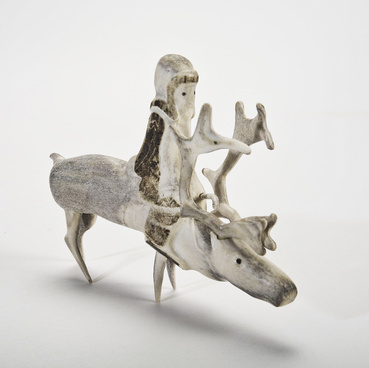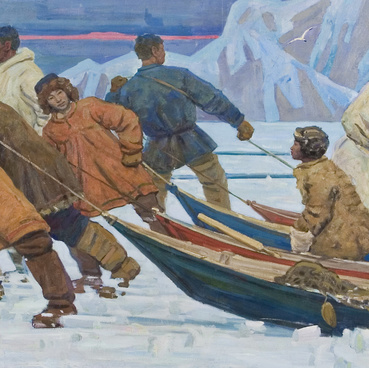Yuri Spiridonov devoted most of his works to the nature and the people of the Arctic. He managed to convey by means of painting the stark beauty of the Northern nature and way of life of the natives. For its documentary accuracy and rich imaginative system, the artist’s work is called the 'the Arctic chronicle'/
The painting 'Master of the Moma Mountains' was created in 2003. The foreground of the painting is a figure of a Northerner. His wrinkles and sunken cheeks testify he has lived a long life. The old man is sitting in a specific position of Northerners: curled up his legs with his arms on the knees. Behind him there is the Moma Range of mountains.
The painter used an unusual view - from the bottom upwards. This technique helped to visualize the Northerner as big as the mountains. Spiridonov’s message was that a Man is equal to the surrounding landscape. The feeling of unity with nature symbolizes joy and fullness of life for the artist, so he chose a light color scheme for the painting.
'Master of the Moma Mountains' color scheme is based on light and dark bluish tones with shades of ocher-color and rose. The artist touched the old man’s forehead, cheeks and lips with gold to recapture the atmosphere of a bright sunny spring day. The darkest spot on the picture is a brown carpet under the man. Such fur mats were widely spread in the Arctic. They were made of deer skin and used for riding and camping.
For the artist the old man represents wisehood and wisdom of the ancient knowledge that the Northern peoples carry. The author makes the expression on his face serious and concentrated. His glance wanders past the spectator and drives on. Spiridonov’s 'Master of the Moma Mountains' praises people of the Arctic, who live in harmony with the Nature.
In one of the interviews the painter said ‘The North is the state of mind’. He was well familiar with the Arctic – Spiridonov was born in 1952 in a far off settlement of Anabar in the North of Yakutia. He comes from a family of reindeer-breeders, who lived nomadically in tundra. Childhood memories of the Northerners heroism and Arctic landscape determined main themes of the artist’s work.



